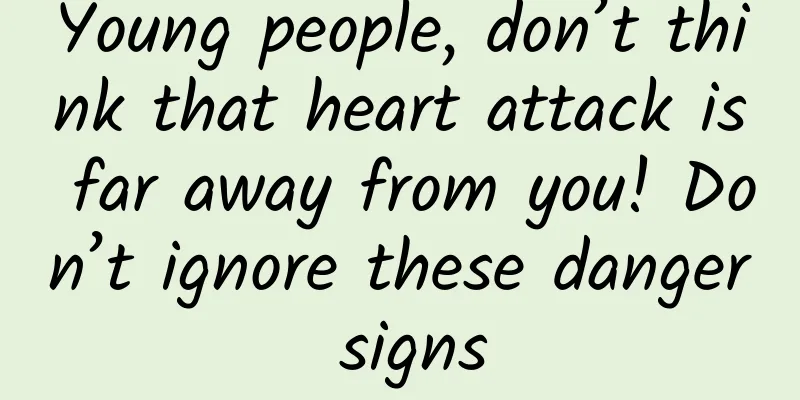Young people, don’t think that heart attack is far away from you! Don’t ignore these danger signs

|
According to the latest research of the "China Cardiovascular Health and Disease Report", the incidence of acute myocardial infarction in my country is showing a significant trend of younger people, and the proportion of patients under 35 years old has increased from 3% 10 years ago to 13%. Statistics from some tertiary hospitals show that the annual increase in patients under 30 years old is as high as 15%. What are the misunderstandings of young people about heart disease? What are the risk factors for heart disease in young people? If symptoms appear, how can we save ourselves and how can we prevent it in normal times? 1. Eliminate four fatal cognitive misconceptions Myth 1: “Normal physical examination = heart safety” Regarding heart disease examinations, routine physical examinations may miss 70% of early lesions and it is difficult to detect plaques in blood vessels. It is recommended that high-risk groups (those who stay up late for a long time, smoke, and are obese) need to undergo some special examinations, such as carotid artery ultrasound, coronary CTA, etc., to understand the situation of plaques in blood vessels. Myth 2: “If there is no chest pain, it is not a heart attack” 40% of myocardial infarction in young patients presents with atypical symptoms such as toothache, stomachache, and back pain. Myth 3: “Fitness experts have strong immunity” Many young people exercise excessively and abuse protein powder, which may accelerate atherosclerosis of blood vessels. Myth 4: “It’s OK to indulge occasionally” Being drunk once will increase the heart load by about 20-30%. Therefore, we should always pay attention to protecting the heart from harm. 2. Six invisible “heart killers” 1. Sleep deficit: Sleeping less than 5 hours for 3 consecutive days will increase the risk of myocardial infarction by 72% 2. Emotional storm: The incidence of anxiety and depression in people is 2.5 times that of normal people 3. Dietary trap: high sugar + high salt + trans fat "takeaway diet" 4. Metabolic crisis: The number of people aged 30 and over with “four highs” (blood pressure/blood lipids/blood sugar/uric acid) increases 5. New nicotine: E-cigarettes cause vascular endothelial damage about 30% faster than traditional cigarettes 6. Sports roller coaster: Sitting for long periods of time on weekdays, but doing intense exercise every weekend, which increases the heart load and induces plaque rupture 3. Four-step gold self-help method 1. Identify early warning signs: Oppressive chest pain lasting more than 15 minutes, not relieved by rest, accompanied by cold sweats, nausea, and a sense of impending death, not relieved by sublingual nitroglycerin 2. Start the first aid procedure: The golden treatment period is within 120 minutes of onset. If the precordial pain persists for more than 15 minutes and cannot be relieved, please call 120 immediately. Because every hour of delay will increase the mortality rate by 10%. 3. Absolute taboos: When precordial discomfort occurs, it is forbidden to drive yourself to see a doctor or force yourself to work despite the pain. 4. Correct treatment process: Lie down immediately → call 120 → chew 300 mg of aspirin (if there are no contraindications) and wait for rescue on the spot (if you are alone at home, keep the door open). IV. Action list for post-90s generation to prevent myocardial infarction 1. Accurate screening: In addition to routine physical examinations, high-sensitivity C-reactive protein and carotid artery ultrasound examinations should be added every year starting from the age of 25. 2. Biological clock revolution: Establish a heart-friendly schedule, try to go to bed before 22:30 every day, and take a 20-minute nap at noon. 3. Smart diet: Implement the "211 diet": 2 fistfuls of vegetables + 1 fistful of protein + 1 fistful of staple food per meal. 4. Fragmented exercise: Get up and do jumping jacks for 3 minutes every hour. 5. Stress management: Set up an "emotional safety valve" and meditate for 10 minutes every day. 6. First aid rehearsal: equipped with emergency kit, first aid card (blood type/allergy history/emergency contact), etc. From today on, please remember that you are the first guardian of your heart, and a scientific lifestyle will always be the most reliable amulet to protect your heart. Author: Ma Fangfang and Xia Ying Department of Internal Medicine, Peking Union Medical College Hospital, Chinese Academy of Medical Sciences Reviewer: Qian Hao, deputy chief physician, Department of Cardiology, Peking Union Medical College Hospital, Chinese Academy of Medical Sciences Produced by: Science Popularization China The pictures and cover picture of this article are from the copyright gallery. Reprinting and using them may cause copyright disputes. |
<<: 180,000 trees! Why do we need to plant Haloxylon ammodendron to prevent wind and fix sand?
>>: There is an "HDR" mode when taking photos. How does it become a "magic tool" for photography?
Recommend
A new variant of the novel coronavirus has emerged? 637 cases have been found! Will it be impossible to eliminate the virus? Wu Zunyou responded
From 0:00 to 24:00 on April 1, 2,129 new confirme...
If information flow advertising can achieve these 3 points, the effect will be reversed in minutes!
A page that can stimulate users' desire to co...
Get 10,000+ users in 7 days, with a conversion rate of over 50%. You only need to do 3 things to achieve group fission
% ignore_pre_1 % When talking about traffic now, t...
Five major mobile application development trends, is your app going astray?
Developers cannot ignore mobile app development i...
Earth Story: A Brief History of Life
Where do we come from? Where are you? Where to go...
Tik Tok’s monetization and commercialization trends!
For commercial products, monetization is an unavo...
Korean automakers' market share in China continues to decline: Hyundai and Kia's sales fell by more than 60% in June
The sluggish sales situation of Korean automakers...
Seven years after Jobs left: Apple's compromise and "betrayal"
In the post-Jobs era, Apple's market value ex...
Affects children's height and IQ...Be careful of these "dangerous foods"!
As the saying goes, illness comes from the mouth....
How do we media people make money? What are the profit models of self-media?
Wow, one day’s income from self-media is equivale...
Chengdu tea tasting private WeChat, 90 minutes 2q to experience the effect personally
Chengdu Tea Pincha’s private WeChat account: Seni...
Wang Daheng: Founder of New China's Optical Industry | Childhood of the Hero of "Two Bombs and One Satellite"
Wang Daheng, the founder of New China's optic...
How did the dugong, which is indistinguishable from a manatee, become the prototype of a mermaid?
Recently, a study jointly completed by scientists...
Do cockroaches no longer like sweets?
When you pick up the dirty laundry basket in the ...
Why is iPhone the first choice for people traveling abroad? These three points are very important
[[392797]] The network is the most realistic prob...









